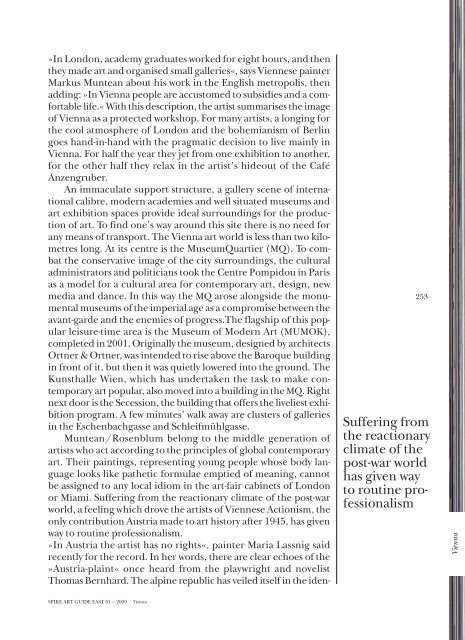Blood - Spike Art Quarterly
Blood - Spike Art Quarterly
Blood - Spike Art Quarterly
Create successful ePaper yourself
Turn your PDF publications into a flip-book with our unique Google optimized e-Paper software.
»In London, academy graduates worked for eight hours, and then<br />
they made art and organised small galleries«, says Viennese painter<br />
Markus Muntean about his work in the English metropolis, then<br />
adding: »In Vienna people are accustomed to subsidies and a comfortable<br />
life.« With this description, the artist summarises the image<br />
of Vienna as a protected workshop. For many artists, a longing for<br />
the cool atmosphere of London and the bohemianism of Berlin<br />
goes hand-in-hand with the pragmatic decision to live mainly in<br />
Vienna. For half the year they jet from one exhibition to another,<br />
for the other half they relax in the artist’s hideout of the Café<br />
Anzengruber.<br />
An immaculate support structure, a gallery scene of international<br />
calibre, modern academies and well situated museums and<br />
art exhibition spaces provide ideal surroundings for the production<br />
of art. To find one’s way around this site there is no need for<br />
any means of transport. The Vienna art world is less than two kilometres<br />
long. At its centre is the MuseumQuartier (MQ). To combat<br />
the conservative image of the city surroundings, the cultural<br />
administrators and politicians took the Centre Pompidou in Paris<br />
as a model for a cultural area for contemporary art, design, new<br />
media and dance. In this way the MQ arose alongside the monumental<br />
museums of the imperial age as a compromise between the<br />
avant-garde and the enemies of progress.The flagship of this popular<br />
leisure-time area is the Museum of Modern <strong>Art</strong> (MUMOK),<br />
completed in 2001. Originally the museum, designed by architects<br />
Ortner & Ortner, was intended to rise above the Baroque building<br />
in front of it, but then it was quietly lowered into the ground. The<br />
Kunsthalle Wien, which has undertaken the task to make contemporary<br />
art popular, also moved into a building in the MQ. Right<br />
next door is the Secession, the building that offers the liveliest exhibition<br />
program. A few minutes’ walk away are clusters of galleries<br />
in the Eschenbachgasse and Schleifmühlgasse.<br />
Muntean/Rosenblum belong to the middle generation of<br />
artists who act according to the principles of global contemporary<br />
art. Their paintings, representing young people whose body language<br />
looks like pathetic formulae emptied of meaning, cannot<br />
be assigned to any local idiom in the art-fair cabinets of London<br />
or Miami. Suffering from the reactionary climate of the post-war<br />
world, a feeling which drove the artists of Viennese Actionism, the<br />
only contribution Austria made to art history after 1945, has given<br />
way to routine professionalism.<br />
»In Austria the artist has no rights«, painter Maria Lassnig said<br />
recently for the record. In her words, there are clear echoes of the<br />
»Austria-plaint« once heard from the playwright and novelist<br />
Thomas Bernhard. The alpine republic has veiled itself in the iden-<br />
SPIKE ART GUIDE EAST 01 — 2009 Vienna<br />
253<br />
Suffering from<br />
the reactionary<br />
climate of the<br />
post-war world<br />
has given way<br />
to routine professionalism<br />
Vienna











